
|
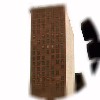
image
THE WANG BUILDING (780 Third Ave.)
[Skidmore, Owings & Merrill]
|
was completed in 1984 as an office tower on Third Avenue.
Originally started as a development of Cadillac-Fairview, the building
was acquired by Jaymont Properties as it was completed.
The exterior of the 173.5 m tall building forms a distinctive
pattern of panels of polished red Balmoral granite from Finland
alternating with window openings, clearly indicating the location of the
outer wall diagonal bracing.
The concrete structural frame uses the off-center core (on the western
side) and the outer wall colonnade, with its large-scale wind bracing,
to form the 50 column-free floors with a total of 43,600 m² of
rentable space. On the longer, avenue-facing sides the
bracing forms a series of X's, while on the shorter sides the bracing
zigzags through the facades. The structure won the Concrete Industry
Board Annual Award in 1983. Each floor also has its own independent
HVAC system.
On the Third Avenue front, the plaza is paved in red brick and granite,
with a row of tress flanking the roadway.
The building incorporates, among other business-related facilities, a
154-seat auditorium as part of the largest office building conference
center in Midtown Manhattan.
|
Elevation
drawing
Official site


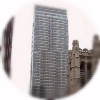
image
THE MUSEUM TOWER (11 W 53rd St.)
[Cesar Pelli & Assocs.]
|
was built in 1984 as the most radical extension to date to the
Museum of Modern Art (MoMA), started on the present
site in 1939 by Philip Goodwin and Edward Durrell Stone,
and later extended by Philip Johnson.
First proposed and outlined in 1976, the slender 52-storey glass tower
was built to help pay for the extension and renovation of the museum --
presently the lower floors of the tower house museum exhibition spaces,
expanding museum's floor area considerably.
This 198 m tall residential tower was constructed with 263 apartments
and cost $55 million to build. The glass facade consists of variously
tinted blue-green opaque glass and has a series of recessed terraces at
the top.
At the moment there are plans for further expansion of the museum
premises, also affecting the tower. Plans by the Japanese architect
Yoshio Taniguchi include the extension to adjacent plots, removal of the glass atrium, as well as altering the south facade of
the tower. The expansion is planned to be complete by 2004.
|


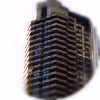
image
THE DAG HAMMARSKJOLD TOWER (240 E 47th St.)
[Gruzen & Partners]
|
was built in 1984 by R. H. Sanbar as a residential high-rise next
to the 1 Dag Hammarskjold Plaza, completed a
decade earlier.
The 43-storey tower with brown brick cladding rises to 137 m and has a
roughly L-shaped plan accented by the faceted protrusions of corner
balconies, made of prefabricated brick elements. Along with living
room strip windows, the balconies form horizontal striping around the
diagonal portion facing the street corner at Second Avenue and 47th
Street. The entrance is located next to this chamfered corner.
There are 133 luxury apartments and such amenities as a health club with
swimming pool and a garage. The building lobby features the Gallery at Dag
Hammarskjold Tower for contemporary art exhibitions.
The actual Dag Hammarskjold Plaza
(link) to the
east occupies a whole blockfront
facing 47th Street between First and Second Avenues. It features, for
example, the Holocaust Memorial Wall and a greenery named Katharine
Hepburn Garden in 1997.
|


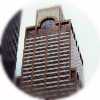
image
THE EQUITABLE CENTER TOWER WEST (787 Seventh Ave.)
[Edward Larrabee Barnes Assoc.]
|
was built in 1985-1986 to Seventh Avenue as the western tower on the
block owned by the Equitable Life Assurance Society.
The facade of this 54-storey building consists of alternating bands
of windows and limestone, interrupted by piers of brown granite.
The tower rises to the height of 228.5 m through two setbacks,
indicated by recessed bays on the north and south facades. The
plain limestone top with its vertical granite striping forms the
last setback and features an arched Romanesque window on both ends
-- this houses the Equitable boardroom.
Included within the 142,660 m² state-of-art building is a
100-seat auditorium, a fitness club and several restaurants as an
effort to attract tenants to this then professionally unfashionable
part of Midtown. Similarly, the building was connected to the
extensive Rockfeller Center underground concourse, and a renovation
was undertaken in the eastern Equitable building on the Sixth Avenue
side.
On the ground floor there is a through-block galleria as well as the
Equitable (now AXA) Gallery for art exhibitions.
In 1986 Roy Liechtenstein enhanced the vast, skylighted entrance
atrium with his large (22.3 x 10.8 m) Mural with Blue
Brushstroke. Primarily a collage of his earlier works, the mural
was sketched on the wall with the aid of slide projectors, and then
painted.
|


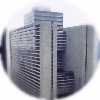
image
THE MARRIOTT MARQUIS HOTEL (1531-1549 Broadway)
[John C. Portman & Assoc.]
|
was completed in 1985 for the Marriott hotel chain on Times Square, on a
site occupied by five theater buildings.
Announced already in 1972, this hotel project was to restore some of the
all-public nature of the old Times Square. Portman, an
architect-developer, acted as a codeveloper also in this project,
collecting no less than 90 percent of the financial backing.
Portman's first plan was in the form of two parallel slabs, connected
only by five-storey bridges. By the time of the final plan he had
incorporated his hotel architecture trademark into the design: an
interior atrium, around which the rooms were grouped.
Originally to be completed in 1977, the hotel was realized only eight
years later, after the financial and planning climate was favourable.
As even the Special Theater District Zoning
Amendment, introduced with the neighbouring
1 Astor Plaza, could not give enough bulk
for the 50-storey building, a zoning remapping was granted, adding a 20
per cent overhead bonus, as well as height and setback variation and a
permit for a 400-car public carage.
The struggle for the preservation of old theater buildings, however,
led to the creation of the Theater
District zoning area and renovation of the Forty-second Street
Theater building by the developers as a "payment" for the zoning
variances of the new hotel.
The entrance to the hotel is via the "caragelike" drivethrough and an
austere street-level elevator lobby, with the main hotel lobby
reachable by elevator, so the hotel isn't one of the most prominent
outwardly -- except for the neon-signs (it's Times Square, after all)
and the lit arches above the street entrances.
Indeed, in addition to the neon advertising signs, the hotel's less
prominent appearance was a direct result of its location in Times
Square. The less savoury neighbourhood of the 1970s and 1980s led to a
design that provided ample blank walls and a guarded entrance from
side-streets.
The hotel building incorporates, in fact, two atria: a smaller one
within the base, around which the shops, restaurants and exhibition and
meeting rooms (54, with 9,300 m² of total space), as well as the
400-seat cinema are grouped, and the 35-storey main atrium
(image), rising from the 13th story lobby. A circular
shaft with tracks on the outside for glass-walled elevators occupies
the center of the atria and rises from the street level to the
revolving lounge bar at the top. The base also houses a revolving
lounge, with views to the street and lower atrium.
Hotel's musical theater is located to the Broadway side of the base,
above the driveway, and has a capacity of 1,050. Also the theater is
accessible from the hotel's street-level lobby by elevators of the
elevator shaft.
The upper atrium has starlit trees and a large, rotating clock around
its midfloor café. The 1,946 hotel rooms and 56 suites are
located both in the north and south slabs as well as the connecting
"bridges", supported by 34 m long trusses and set to different distances
from the elevator shaft. The rooms are entered from the inside
balconies and have views to both outside and to the atrium.
|


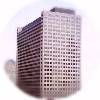
image
THE 7 WORLD TRADE CENTER(demolished)
[Emery Roth & Sons]
|
was built in 1984-1985 as an addition to the
World Trade Center, located across
Vesey Street from the main compound.
Although a part of the WTC in name, the Silverstein
Properties-developed building, also known as the Tishman Center
after its constructors, was on a separate ground lease and tax lot
from the rest of the Center (see
map). The building was
built atop the power substation building that supplied much of
Downtown Manhattan with electricity. To make matters worse, the
foundations had to be built through the building avoiding not only
the operational equipment there, but also the ramp serving the
WTC and a subway line. Moreover, the WTC towers caused wind
conditions that required special stiffening determined by
computer-run wind analysis.
The resulting frame was divided into two distinct zones, with the
first seven floors built around a stiffened central core that
was connected through braced floor slabs to a wind truss system on
the lower east and west walls. From seventh to the top, the braced
outer wall was augmented by two two-storey "belts" against high wind
forces. On the north side, the outer wall above the seventh floor up
cantilevered two meters over the substation building, which required
the installation of 20 m long tapering girders to be installed from
the core to the outer wall.
As the existing foundations through the substation building were
mostly not aligned with the perimeter colonnade of the new tower,
they had to be fitted with concrete caps to allow transfer of loads
to the foundations. For the core, the loads were transferred through
a heavily braced foundation slab. 50 new foundation "caissons" were
built, most of which had to be squeezed through the substation
building.
Although not small by any standards -- built on Port Authority land,
it was exempt from zoning regulations and could occupy the whole
trapezoidal plot with no setbacks -- the building's 44 4,450 m²
floors and height of 160 m were obviously dwarfed by its older twin
brothers. The building's appearance and its alternating facing
(horizontal glass striping on the Barclay and Vesey Street sides and
red granite, holed by smaller windows, on the other two) set it apart
also visually from the Twin Towers of the late 1960s.
The building was from the onset equipped with its own power substation
for reselling of electricity to the tenants. After the 1993 terrorist
attack in the World Trade Center, the mayoral emergency command center
was built within the building, with its own power generators for
emergency electricity generation.
In front of the building, on the WTC compound plaza level, stood
Alexander Calder's 8-meter steel sculpture
Three Red Wings as well as pedestrian bridges over Vesey Street
from the WTC compound, with a round plexiglass tube covering
(image) the eastern one.
The occupation of the building went through the same difficulties as
its larger twin brethren. The investment bank Drexel Burnham Lambert
(best known for its star dealer, the notorious "junk bond king"
Michael Milken) was to become a tenant in 1986 but backed out in favour
of the eventually ill-fated Boston Properties' go at the
Columbus Circle; in 1988 Salomon Brothers
finally relieved Silverstein with their lease of half of the ofice
space.
The building collapsed during the terrorist attack on the WTC in
September 2001, having been structurally weakened by the destruction
of the nearby WTC towers. A theory strongly suggests that the large
amount of diesel fuel for the emergency generators stored within
the building (for the use of, for example, the Mayor's emergency
center) could have created the heat that led to the collapse.
Especially as none of the other skyscrapers surrounding the WTC were
structurally fatally damaged.
New development on the site
|



image
THE 100 U.N. PLAZA
[Schuman, Lichtenstein, Claman & Efron Architects and Der Scutt
Architects]
|
was completed in 1986 by Albanese Development as a residential tower to the
north-west from the United Nations.
The 52-storey building sports an all-black facing not unlike in appearance
to the Trump World Tower next door.
In fact, too much next door for the liking of many of the 100 U.N. Plaza
residents, as the super-tall neighbour blocks the view to the U.N.
complex.
The brick-clad shaft of the tower slab is set-back from the street and
rises vertically with balconies on the corners and mid-portions of the
north and south facades, until the eight top apartment floors, where its
east and west facades taper shaply to form a top wedge. The balconies of
these apartments protrude as horizontal "ribs" and extend around the
corners of the slopes. The top triangle at 170 m houses the mechanical
floors and heat exchangers.
The triangular theme of the top extends to the ground floor lobby with its
triangular window arches -- being gold-trimmed inside the lobby and
complemented with gold striping on the walls -- and pitched-roof entrance
canopy, also gold-tinted, on the plaza side. There are 267 apartments in
the building.
The landscaped plaza by Thomas Balsley Assocs. is located on the
east side of the building, extending to First Avenue. In addition to
fountains and greenery, the multilevel plaza consists of extensive
brickwork extending to the sidewalks along both the plaza and the building.
|
Elevation drawing


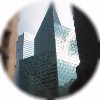
image
THE 599 LEXINGTON AVENUE
[Edward Larrabee Barnes Assoc.]
|
was built in 1986 for the Boston Properties.
The building is located next to the Citicorp
Center, with an equally "angled" appearance and an aluminium facade
with horizontal stripes of windows. All the window stripes have the
upper half consisting of light blue "shades" above the open window
panel.
The main shaft of the 47-storey building is rectangular, with a
triangular portion on the Lexington Avenue side pointing to the street,
the top of the building at 199 m is in the shape of a triangular prism
pointing to the opposite direction.
Cantilevered under the diagonally sliced-off corner on the Citicorp
side -- providing an open view along Lexington Avenue to the Center --
and set behind a single round column is the entrance to the lobby,
with all-glass walls facing building's triangular plaza. The
lobby has banded white marble decor in the vein of Italian Renaissance
as well as artwork Salto Nel Mio Sacco (1985) by Frank Stella.
The paved plaza has, similarly to Citicorp Center's, an entrance to a
subway station, in this case a stairway covered with a slanted glass
canopy consisting of large panes.
|
The Cityreview
entry


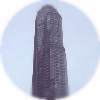
image
THE CITYSPIRE (156 W 56th St.)
[Helmut Jahn]
|
or the City Center Tower, was completed in 1989 as a 72-storey office
and apartment building, the city's tallest mixed-use skyscraper.
The 77,100 m² building uses the air rights of the adjacent City
Center for the Performing Arts (arch. Harry P. Knowles and
Clinton & Russell, 1924). This glass tower of a primarily
octagonal plan has streamlined extension wings that set back along
with the gradual decrease of the central octagon's diameter. The
octagon has a vertically accentuated glass facade, while the wings
feature horizontal strips of glass and marble. The tower ends in a
domed top at the height of 248 m (the dome being a nod towards the
City Center building).
As a residential tower, the building uses a concrete structural
system, being at the time of its completion the second tallest
concrete-framed skyscraper in the world.
The two lobbies (for the residential and office sections of the
building) are lavishly decorated with marble and wood. The bottom 23
floors of the tower are for commercial use and above it there are 353
luxury apartments, growing in size the higher they are. At the top
there are two 200 m² apartments. There is also a health club for
the tower residents.
Standing alongside the Carnegie Hall Tower
and the Metropolitan Tower, these
buildings form the tallest group of skyscrapers in this area north of
Theater District.
|


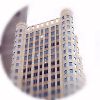
image
THE 33 MAIDEN LANE
[Philip Johnson and John Burgee]
|
continued in 1986 the Johnson/Burgee adaptations of historic
styles in New York City high-rises.
The building site was originally planned for the use of the next-door
neighbour Federal Reserve Bank's extension, but this privately
developed office building eventually occupied the plot -- albeit also
the bank eventually leased space from the building.
The building draws its inspiration from medieval castle design, with
the multiple round towers which extend to the ground, as well as the
holed balustrade at the building top, impersonating a battlement.
The regular row of windows running through the whole building brings
the design inevitably to the late 20th century, with the resulting air
of lightness and transparency.
As well as the circular pillars, also a set of narrower columns
in-between define the building on the street level. They support a
high arcade, behind which is the glass-walled lobby.
|



image
THE 885 THIRD AVENUE ("LIPSTICK BUILDING")
[Philip Johnson & John Burgee]
|
completed in 1986, this building followed the
ex-AT&T Building and continued Johnson's
process of providing NYC skyscrapers with a new and more unconventional
form and style.
The 143 m tall building consists of four oval-shaped cylinders placed
above each other, each smaller in diameter than the one below, creating
the building a set-back appearance. On the 36-storey facade, red
granite spandrels alternate with the shiny steel of horizontal window
bands.
The elliptical lobby has a colonnade of steel-banded and "hat-topped"
round pillars along the glassed outer wall line, and the columns double
on the outside, forming a narrow arcade there.
Due to the placement of the elevators to the side away from Lexington
Avenue, the "cylinders" are offset to the mid-block. One result of the
unusual form of the building was the required installation of
customized HVAC and ventilation fixtures, with the appropriate cost
effects.
The building features 54,200 m² of office and 740 m² of
retail space.
|


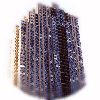
image
THE SOUTH PARK TOWER (124 W 60th St.)
[Buck/Cane Architects]
|
was completed in 1986 for the Brodsky Organization as an Upper West Side
residential high-rise.
The brick-clad, 52-storey slab faces east and west, straddling its
mid-block site between 59th and 60th Streets. The set-back top at 157.5 m
creates double terraces facing south.
The building incorporates 498 rental apartments as well as a health club
and 9,300 m² of medical offices for the nearby Roosevelt Hospital,
with a separate entrance with ziggurat themes from 59th Street. The
carage has space for 125 cars.
|


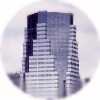
image
THE 1 FINANCIAL SQUARE (32 Old Slip)
[Edward Durrell Stone Assocs.]
|
was built in 1984-1987 to South Street in Financial District as an office
building.
The site was originally owned by the Federal Government and contained the
U.S. Assay Building (arch. James A. Wetmore, 1930). As the New York
Assay Office, which had operated since 1853, was closed down in 1982, the
plot was sold for $27 million.
The new development utilized the air rights from a demolished fire
station (which is now located within the building, on the South Street
side) and the neo-Renaissance 100 Old Slip, a former police station and
the home of the NY Police Museum next door to the south.
The base of the building features a rectangular-in-plan, neo-Classical
granite colonnade enclosing a 12 m high outside arcade with rectangular
clerestory openings at the top. The base material and texture is a nod
towards the landmarked Police Museum building.
Above the gray granite-clad base, the 37-storey building forms a tower
plan of granite-clad, strip-windowed rectangle with corners of
chamfered, dark-tinted glass curtain wall. This basic form then
gradually transforms in a series of jagged steps and set-backs to a
fully glass-walled octagon reaching 175.5 m.
Entrance to the building is from three of the corners (the fourth is for
basement parking entrance), underneath the
diagonal curtain wall portions, but set-back from the wall line so that
the building corner columns extend through the atrium space (image). The colonnades and openings are echoed in the
lobby outer walls, albeit naturally glazed. The lobby is of the same
height as the atrium and has brown marble decor, floor paving in light
tone and elevator bank walls in darker tones.
In plan, the office floors feature 16 corners in every configuration to
the last granite-clad set-back. In all, the building incorporates
101,300 m² of office space, including a trading floor. 26
elevators serve the floors.
There is a public plaza along Gouverneur Lane, clad in the same red
paving stones as the arcade and sidewalks.
Paramount Group purchased the building for $135 million in 1995.
|
iPix 3D Views
Floor plans


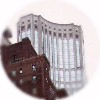
image
THE 135 EAST 57TH STREET
[Kohn Pedersen Fox Assocs.]
|
was completed in 1988 by Madison Equities as an office building along
Lexington Avenue.
The building consists of two masses as a generally L-shaped entity.
Facing the plaza at the corner of Lexington Avenue and 57th Street, the
32-storey curving facade of the tower rises all the way to the top at
131 m. The corners of its top portion are chamfered, starting from the
roof level of the adjoining lower wing to the west, in turn topped by an
arched feature, housing what might be a solar panel installation. Both
masses are set back from the base which has horizontally accentuated
stone facing on the first two floors. The
neo-Classical facades are clad in gray granite and feature unbroken
vertical window stripes.
The building incorporates 42,900 m² of office and retail space.
As the building was constructed from the beginning as an antiques center,
the retail space design caters to these special needs; the walls and
floors were specially protected against any dampness that might be
seeping through and double doors are used to minimize humidity from the
outside.
In 1997, Cohen Brothers obtained the building for $113 million and made a
renovation that was completed in September 2001.
The plaza in front of the curving main facade is elevated from the
street level and features a round granite "temple" flanked with fountains
as its sculptural piece (image).
The Cohen Park, named after the owners, is a vest-pocket plaza next to the entrance to the Galleria next door. The
park is enclosed within a two-floor-high extension of the street facade
and features a 4.5-meter illuminated waterfall and landscaping by
Thomas Balsley as well as sculptures by Franco Scuderi.
|
The Cityreview entry


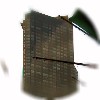
image
THE METROPOLITAN TOWER (146 W 56th St.)
[Schuman, Lichtenstein, Claman & Efron Architects]
|
was completed in 1988 by Macklowe Properties as an office-residential
tower.
Originally, there had been plans for a joint high-rise development
combining also the plot of the Carnegie Hall
Tower. The plan came to nothing as the owner of the Russian Tea
Room, which is located between the plots and extends through the block,
refused to sell her property.
Eventually both towers were built independently on their separate
plots, only the 6-meter width of the restaurant's site separating them
in the skies.
Clad in a dark glass curtain wall and rising from a rectangular base
in scale with the surrounding buildings on 57th Street, the 68-storey
tower differs strikingly in appearance from its rectangular,
contextual colour brick neighbour. The tower has a triangular plan
with the diagonal side facing north-east, towards Central Park. With
only a notch at the top of the north edge and the jagged south edge
breaking the prism form, the tower rises to the height of 218 m.
The building houses offices in the lower floors with 234 apartments
on 49 floors occupying the upper portion of the tower. The residential
portion features a private restaurant with outdoor terrace as well as
a health club with a swimming pool.
The 56th street wall is set back from the plot line, forming a plaza
with large brick planters.
The lobby extends through the block; the ground floor has 280
m² of retail space and there is a basement garage.
L&L Acquisitions and Principal Life Insurance Co. bought the 22,800
m² office portion of the building for $120 million in June 2005.
|
The
Cityreview entry


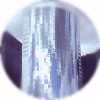
image
THE 17 STATE STREET
[Emery Roth & Sons]
|
of 1988 occupies the curved plot at the intersection of State Street
and Water Street.
The building replaced the cross-topped Seamen's Church Institute
hostel only 16 years after its completion.
The plan of the building is in the shape of a quarter of a circle and
the most striking portion of the facade, the curving wall of bluish
glass, faces south, distinguishably different from the 1970s buildings
that have so far dominated the immediate surroundings of the South
Ferry.
The structural system of the building is visible at the ground floor
level, where the perimeter columns support the uplifted facade, and
the diagonally-braced center core and elevator shafts are visible
behind glass curtain. (image).
A floor up, the building's main lobby has walls of glass as well as
cobblestone paving.
Nesting beside the skyscrapers, the historic, colonnaded building at
7-8 Broad Street is the only remaining 18th Century private house in
Downtown Manhattan.
|


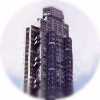
image
THE CENTRAL PARK PLACE (301 W 57th St.)
[Davis, Brody & Assocs.]
|
was built in 1988 as a luxury apartment tower near Columbus Circle.
The 56-storey building "duels" about the dominance of Columbus Circle
airspace with the ex-Gulf and Western
Building, facing it across the traffic circle. Until the completion
of the planned New Coliseum project
to replace the neighbouring New York Coliseum west of the Circle, these
towers will continue to dominate the immediate surroundings.
The alumium-clad building is characterized by numerous setbacks and
angled protrusions -- which offer views to three directions -- the rise
ending to an octagonal water tank housing at 191.5 m. The building has
a total of 160 apartments, as well as a health club and a roof-top
sundeck.
|


ENTRANCE
CONTENTS
INTRODUCTION
ALPHABETICAL LIST
EARLY CENTURY I &
II
ART DECO ERA I &
II &
III
INTERNATIONAL STYLE I &
II &
III
POST-MODERNISM I &
II
NEW DEVELOPMENTS
ADDITIONAL INFO I &
II &
III &
IV
ARCHITECTS
DEVELOPERS
TOPICS INDEX
FORUM
LINKS
SITE SEARCH
MAPS:
DOWNTOWN
VILLAGES
WEST MIDTOWN
EAST MIDTOWN
UPTOWN
 © e t dankwa
23 March 2008
© e t dankwa
23 March 2008
|
![]()
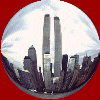
![]()

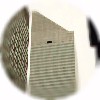


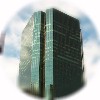
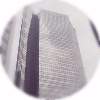
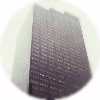

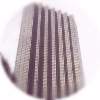


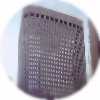
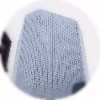
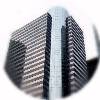
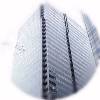

















 © e t dankwa
23 March 2008
© e t dankwa
23 March 2008